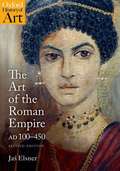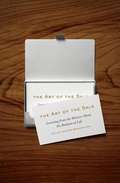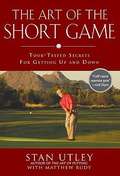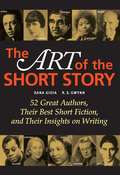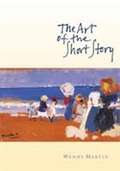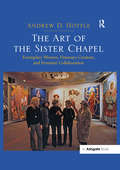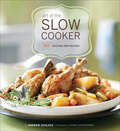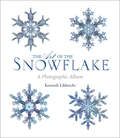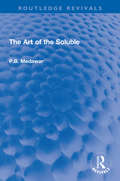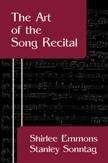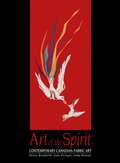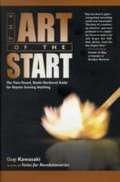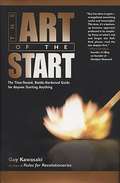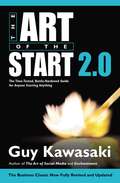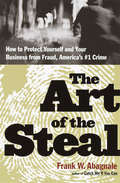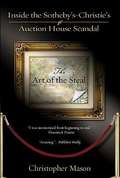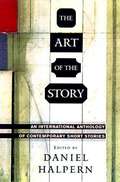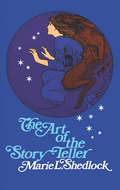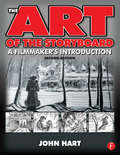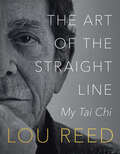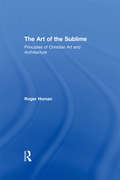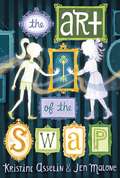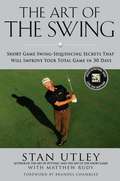- Table View
- List View
The Art of the Roman Empire: 100-450 AD, Second Edition (Oxford History of Art)
by Jas EisnerThe passage from Imperial Rome to the era of late antiquity, when the Roman Empire underwent a religious conversion to Christianity, saw some of the most significant and innovative developments in Western culture. This stimulating book investigates the role of the visual arts, the great diversity of paintings, statues, luxury arts, and masonry, as both reflections and agents of those changes. <P><P>Jas' Elsner's ground-breaking account discusses both Roman and early Christian art in relation to such issues as power, death, society, acculturation, and religion. By examining questions of reception, viewing, and the culture of spectacle alongside the more traditional art-historical themes of imperial patronage and stylistic change, he presents a fresh and challenging interpretation of an extraordinarily rich cultural crucible in which many fundamental developments of later European art had their origins. <P><P>This second edition includes a new discussion of the Eurasian context of Roman art, an updated bibliography, and new, full colour illustrations.
The Art of the Sale: Learning from the Masters About the Business of Life
by Philip Delves BroughtonFrom the author of Ahead of the Curve, a revelatory look at successful selling and how it can impact everything we do The first book of its kind, The Art of the Sale is the result of a pilgrimage to learn the secrets of the world's foremost sales gurus. Bestselling author Philip Delves Broughton tracked down anyone who could help him understand what it took to achieve greatness in sales, from technology billionaires to the most successful saleswoman in Japan to a cannily observant rug merchant in Morocco. The wisdom and experience Broughton acquired, revealed in this outstanding book, demonstrates as never before the complex alchemy of effective selling and the power it has to overcome challenges we face every day.
The Art of the Short Game
by Matthew Rudy Stan Utley?The hottest instructor in golf? (Sports Illustrated) takes on old-school gurus with a far more accessible, intuitive, and innovative approach to those essential chip shots, pitches, and bunker rescues. Veteran golfers know that the secret to a lower score is a solid short game, but mastering those small strokes can be maddening?even for the pros. One of golf?s most revered instructors, Stan Utley now reveals the step-by-step tactics behind his revolutionary short-game techniques in The Art of the Short Game. After introducing readers to his groundbreaking philosophy that explains why most players don?t see all the shots available to them near the green, Utley moves on to shatter conventional wisdom about stance, grip, and ball position. From choosing the right clubs (including a checklist of must-haves that should always be in your bag) to spin reduction during chipping and fearless sand play, The Art of the Short Game demystifies the most aggravating shots on the links. Though Utley?s primer features a full set of drills, accompanied by more than seventy-five photos, his approach is far removed from the monotonous, mechanical instruction of yesteryear. Giving a time-tested secret weapon to every golfer at every level, Utley?s short-game methods turn trouble shots into triumph.
The Art of the Short Story
by Dana Gioia R. S. GwynnThis affordably-priced collection presents masterpieces of short fiction from 52 of the greatest story writers of all time. From Sherwood Anderson to Virginia Woolf, this anthology encompasses a rich global and historical mix of the very best works of short fiction and presents them in a way students will find accessible, engaging, and relevant. The book's unique integration of biographical and critical background gives students a more intimate understanding of the works and their authors.
The Art of the Short Story: Stories and Authors in Historical Context
by Wendy MartinThis historically arranged anthology of short fiction by top American and international writers provides a comprehensive collection of both the classic stories as well as the most effective, relevant, and engaging modern and contemporary short stories. Through four distinct historical units, the author looks at the development of the short story as a genre. The historical introductions and visual spreads that begin each unit help instructors and students place the stories they read in a broader context. In addition to delineating the history and future of the short story, the anthology provides a comprehensive collection of classical and traditional stories and demonstrates the liveliness, flexibility, and dynamic nature of the genre. This dual focus grounds students in the tradition of the short story genre and gives them an appreciation for its contemporary context. Unlike many introductions to short fiction, this anthology includes a strong representation of newer works by international and American writers.
The Art of the Sister Chapel: Exemplary Women, Visionary Creators, and Feminist Collaboration
by Andrew HottleThe Sister Chapel (1974-78) was an important collaborative installation that materialized at the height of the women�s art movement. Conceived as a nonhierarchical, secular commemoration of female role models, The Sister Chapel consisted of an eighteen-foot abstract ceiling that hung above a circular arrangement of eleven monumental canvases, each depicting the standing figure of a heroic woman. The choice of subject was left entirely to the creator of each work. As a result, the paintings formed a visually cohesive group without compromising the individuality of the artists. Contemporary and historical women, deities, and conceptual figures were portrayed by distinguished New York painters-Alice Neel, May Stevens, and Sylvia Sleigh-as well as their accomplished but less prominent colleagues. Among the role models depicted were Artemisia Gentileschi, Frida Kahlo, Betty Friedan, Joan of Arc, and a female incarnation of God. Although last exhibited in 1980, The Sister Chapel has lingered in the minds of art historians who continue to note its significance as an exemplar of feminist collaboration. Based on previously-unpublished archival materials and featuring dozens of rarely-seen works of art, this comprehensive study details the fascinating history of The Sister Chapel, its constituent paintings, and its ambitious creators.
Art of the Slow Cooker: 80 Exciting New Recipes
by Andrew SchlossDelicious one pot recipes that simmer while you relax—slow cooked meals suitable for everyday and entertaining—includes photos. For the Art of the Slow Cooker, best-selling author Andrew Schloss has developed eighty recipes for soups, stews, succulent braises, vegetarian dishes—even desserts—that bring slow-cooked meals to new heights. Slow cooking gives a wonderful velvety texture to meatloaf, an incredible richness to Osso Buco Milanese, and bold and complex flavors to Curried Vegetables and Dal simmered in Indian spices. Each chapter offers recipes for both simple everyday meals and spectacular dishes perfect for entertaining. With cooking charts to help with timing, advice on finding the right slow cooker for every kitchen, and glorious color photographs throughout, the Art of the Slow Cooker will delight readers looking for easy and amazing meals.
The Art of the Snowflake: A Photographic Album
by Kenneth LibbrechtThe perfect geometry and exquisite beauty of nature is nowhere so clear to us as in the snowflake. But how have we been able to appreciate this infinitesimal wonder in all its crystalline glory? This book, as much a work of art as a testament to science, reveals how one of the snowflake&’s most inspired photographers came to such intimate knowledge of his craft and its fleeting focus. Beautiful pictures illustrate Kenneth Libbrecht&’s story of the microphotography of snow crystals, from the pioneering work of Wilson Bentley in the 1890s right up to Ken&’s own innovations in our age of digital images. A breathtaking look at the works of art that melt in an instant, this is a book to page through and savor, season after season.
The Art of the Soluble (Routledge Revivals)
by P.B. MedawarFirst published in 1967, The Art of the Soluble presents collection of essays giving the views of the author on creativity and originality in science and on the logical connections between creative and critical thought. It is also a pioneering study of the ethology of the scientists – of the anatomy of scientific behaviour. Is it true that scientists are detached or dispassionate observers of Nature? What underlies the scientist’s deep concern over the matters of priority? How did a class distinction grow up between pure and applied science? By what criteria do scientists value their own and their colleagues work? Some of the answers grow out of author’s four critical studies of Teilhard de Chardin, Arthur Koestler, D’Arcy Thompson and Herbert Spencer and the book as whole is knit together by a major essay Hypothesis and Imagination, on the nature of scientific reasoning. P. B. Medawar, who won the Nobel Prize for Medicine in 1960, did not see science as a book-keeping of Nature but, on the contrary, as the greatest of human adventures. This book will be an essential read for scholars and researchers of philosophy of Science, natural science, and philosophy in general
The Art Of The Song Recital
by Shirlee Emmons Stanley SonntagThe definitive work in its field! Since its original publication, the Emmons-Sonntag text has continually stood out as the definitive work on the song recital. The book presents imaginative advice and practical techniques for producing successful recitals and kindling audience excitement. Every aspect of the recital is covered, from building programs and the use of acting skills to the relationship between the singer and the accompanist. Singers of all levels and backgrounds will benefit from the authors' vast experience in the performance of song recitals as a singer/accompanist team. The comprehensive repertoire lists, now organized by voice and instrumentation as well as by composer, appeal to both students and professional musicians. Readers will agree that the authors have met their goal of providing "extensive, thoroughgoing, and definitive insights into the attributes that can render the song recital at once a great art and a magnificent entertainment."
Art of the Spirit: Contemporary Canadian Fabric Art
by Helen Bradfield Joan Pringle Judy RidoutRich colours and arresting designs capture the mood of celebration and joy that characterizes this photographic record of contemporary religious works of art. Chosen for their excellence in design and stitchery, these works represent the achievements of artists who have created art, in fabric, for places of worship. This book celebrates this important artistic expression, a significant part of our heritage. Pieces are selected from communities across Canada: from a small parish on a Micmac reserve in Nova Scotia to a large urban synagogue in Vancouver; from the igloo-shaped cathedral in Iqaluit to a suburban church nestled beside a wildlife march in southwestern Ontario.
The Art of the Start: The Time-Tested, Battle-Hardened Guide for Anyone Starting Anything
by Guy KawasakiThe Art of the Start will give you the essential steps to launch great products, services, and companies whether you are dreaming of starting the next Microsoft or a not-for-profit that's going to change the world.
The Art of the Start
by Guy KawasakiA new product, a new service, a new company, a new division, a new anything-where there's a will, Guy Kawasaki shows the way with his essential steps to launching one's dreams.
The Art of the Start
by Guy KawasakiA new product, a new service, a new company, a new division, a new organization, a new anything--where there's a will, here's the way. It begins with a dream that just won't quit, the once-in-a-lifetime thunderbolt of pure inspiration, the obsession, the world-beater, the killer app, the next big thing. Everyone who wants to make the world a better place becomes possessed by a grand idea. But what does it take to turn your idea into action? Whether you are an entrepreneur, intrapreneur, or not-for-profit crusader, there's no shortage of advice available on issues such as writing a business plan, recruiting, raising capital, and branding. In fact, there are so many books, articles, and Web sites that many startups get bogged down to the point of paralysis. Or else they focus on the wrong priorities and go broke before they discover their mistakes. In The Art of the Start, Guy Kawasaki brings two decades of experience as one of business's most original and irreverent strategists to offer the essential guide for anyone starting anything, from a multinational corporation to a church group. At Apple in the 1980s, he helped lead one of the great companies of the century, turning ordinary consumers into evangelists. As founder and CEO of Garage Technology Ventures, a venture capital firm, he has field-tested his ideas with dozens of newly hatched companies. And as the author of bestselling business books and articles, he has advised thousands of people who are making their startup dreams real. From raising money to hiring the right people, from defining your positioning to creating a brand, from creating buzz to buzzing the competition, from managing a board to fostering a community, this book will guide you through an adventure that's more art than science--the art of the start.
The Art of the Start 2.0: The Time-Tested, Battle-Hardened Guide for Anyone Starting Anything
by Guy KawasakiFully revised and expanded for the first time in a decade, this is Guy Kawasaki's classic, bestselling guide to launching and making your new product, service, or idea a success.Whether you're an aspiring entrepreneur, small-business owner, intrapreneur, or not-for-profit leader, there's no shortage of advice on topics such as innovating, recruiting, fund raising, and branding. In fact, there are so many books, articles, websites, blogs, webinars, and conferences that many startups get paralyzed, or they focus on the wrong priorities and go broke before they succeed. The Art of the Start 2.0 solves that problem by distilling Guy Kawasaki's decades of experience as one of the most hardworking and irreverent strategists in the business world. Guy has totally overhauled this iconic, essential guide for anyone starting anything. It's 64 percent longer than version 1.0 and features his latest insights and practical advice about social media, crowdfunding, cloud computing, and many other topics. Guy understands the seismic changes in business over the last decade: Once-invulnerable market leaders are struggling. Many of the basics of getting established have become easier, cheaper, and more democratic. Business plans are no longer necessary. Social media has replaced PR and advertising as the key method of promotion. Crowdfunding is now a viable alternative to investors. The cloud makes basic infrastructure affordable for almost any new venture. The Art of the Start 2.0 will show you how to effectively deploy all these new tools. And it will help you master the fundamental challenges that have not changed: building a strong team, creating an awesome product or service, and facing down your competition. As Guy likes to say, "Entrepreneur is a state of mind, not a job title." His book will help you make your crazy ideas stick, through an adventure that's more art than science - the art of the start.
The Art of the Steal: How to Protect Yourself and Your Business from Fraud, America's #1 Crime
by Frank W. AbagnaleThe world--famous former con artist and bestselling author of Catch Me if You Can now reveals the mind--boggling tricks of the scam trade--with advice that has made him one of America's most sought--after fraud--prevention experts."I had as much knowledge as any man alive concerning the mechanics of forgery, check swindling, counterfeiting, and other similar crimes. Ever since I'd been released from prison, I'd often felt that if I directed this knowledge into the right channels, I could help people a great deal. Every time I went to the store and wrote a check, I would see two or three mistakes made on the part of the clerk or cashier, mistakes that a flimflam artist would take advantage of. . . . In a certain sense, I'm still a con artist. I'm just putting down a positive con these days, as opposed to the negative con I used in the past. I've merely redirected the talents I've always possessed. I've applied the same relentless attention to working on stopping fraud that I once applied to perpetuating fraud."In Catch Me if You Can, Frank W. Abagnale recounted his youthful career as a master imposter and forger. In The Art of the Steal, Abagnale tells the remarkable story of how he parlayed his knowledge of cons and scams into a successful career as a consultant on preventing financial foul play--while showing you how to identify and outsmart perpetrators of fraud.Technology may have made it easier to track down criminals, but cyberspace has spawned a skyrocketing number of ways to commit crime--much of it untraceable. Businesses are estimated to lose an unprecedented $400 billion a year from fraud of one sort or another. If we were able to do away with fraud for just two years, we'd erase the national debt and pay Social Security for the next one hundred years. However, Abagnale has discovered that punishment for committing fraud, much less recovery of stolen funds, seldom happens: Once you're a victim, you won't get your money back. Prevention is the best form of protection. Drawn from his twenty-five years of experience as an ingenious con artist (whose check scams alone mounted to more than $2 million in stolen funds), Abagnale's The Art of the Steal provides eye-opening stories of true scams, with tips on how they can be prevented. Abagnale takes you deep inside the world and mind of the con artist, showing you just how he pulled off his scams and what you can do to avoid becoming the next victim. You'll hear the stories of notorious swindles, like the mustard squirter trick and the "rock in the box" ploy, and meet the criminals like the famous Vickers Gang who perpetrated them. You'll find out why crooks wash checks and iron credit cards and why a thief brings glue with him to the ATM. And finally, you'll learn how to recognize a bogus check or a counterfeit bill, and why you shouldn't write your grocery list on a deposit slip.A revealing look inside the predatory criminal mind from a former master of the con, The Art of the Steal is the ultimate defense against even the craftiest crook.
The Art of the Steal
by Christopher MasonThe Art of the Steal tells the story of several larger-than-life figures - the billionaire tycoon Alfred Taubman; the most powerful woman in the art world, Dede Brooks; and the wily British executive Christopher Davidge - who conspired to cheat their clients out of millions of dollars. It offers an unprecedented look inside this secretive, glamorous, gold-plated industry, describing just how Sotheby's and Christie's grew from clubby, aristocratic businesses into slick international corporations. And it shows how the groundwork for the most recent illegal activities was laid decades before the perpetrators were caught by federal prosecutors.
The Art Of The Story: An International Anthology Of Contemporary Short Stories
by Daniel HalpernFollowing the immense success of The Art of the Tale, Daniel Halpern has assembled the next generation of short-story writers -- those born after 1937 -- to create a companion volume, The Art of the Story. Attesting to the depth, range, and continued popularity of short fiction, this collection includes seventy-eight contributors from thirty-five countries. The Art of the Story combines the best of the established masters as well as the fresh, new voices of writers whose work has seldom been translated into English.
The Art of the Story-Teller
by Marie L. Shedlock"It is a delight to see a new edition of this long out-of-print book, the best on the subject of stpry-telling." -- The Junior Bookshelf. Everything you need to know to tell stories successfully to children: choosing material, using gestures, capturing straying attentions, more. 18 ready-for-telling stories written especially for youngsters. Annotated bibliography of 135 stories.
The Art of the Storyboard: A filmmaker's introduction
by John HartCommunicate your vision, tell your story and plan major scenes with simple, effective storyboarding techniques. Using sketches of shots from classic films, from silents to the present day, John Hart leads you through the history and evolution of this craft to help you get to grips with translating your vision onto paper, from the rough sketch to the finished storyboard. More than 150 illustrations from the author's and other storyboard artists' work illuminate the text throughout to help you master the essential components of storyboarding, such as framing, placement of figures, and camera angles.Level: Novice
The Art of the Straight Line: My Tai Chi
by Lou Reed Laurie AndersonThe Art of the Straight Line captures the energy of Lou Reed’s worlds of Tai Chi, music, and meditation. It was edited by his wife, the artist Laurie Anderson, with Stephan Berwick, Bob Currie, and Scott Richman.Lou Reed was a musician, singer, songwriter, poet, and founding member of the legendary rock band the Velvet Underground. He collaborated with many artists, from Andy Warhol and John Cale to Robert Wilson and Metallica. Reed had a groundbreaking solo career that spanned five decades until his death in 2013.Reed was also an accomplished martial artist whose practice began in the 1980s. He studied with Chen Tai Chi pioneer Master Ren GuangYi. This book is a comprehensive collection of Reed’s writings on Tai Chi. It includes conversations with Reed’s fellow musicians, artists, friends, and Tai Chi practitioners, including Julian Schnabel, A. M. Homes, Hal Willner, Mingyur Rinpoche, Eddie Stern, Tony Visconti, and Iggy Pop.Including over 150 photos, ephemera, and a color photo insert, The Art of the Straight Line features Reed’s unpublished writings on the technique, practice, and purpose of martial arts, as well as essays, observations, and riffs on meditation and life.
The Art of the Strategist: 10 Essential Principles For Leading Your Company To Victory
by William CohenFrom ancient battlefields to the modern business landscape, competitors have tried innumerable approaches to conquering adversaries. Success for the victors has taken many forms and traveled many paths, but at its heart, winning strategy can be boiled down to ten universal principles. When learned and implemented, these principals become powerful drivers of business excellence. Renowned strategy expert William A. Cohen, whose considerable experience in the military, corporate, and academic sectors forms the basis for The Art of the Strategist, presents the timeless lessons of: * commitment to a definite objective * seizing and maintaining the initiative * economization to mass (concentration of resources) * positioning * surprise * multiple simultaneous alternatives * the indirect approach * simplicity * timing * exploiting success With examples including the conquests of Hannibal and Alexander the Great, the political triumphs of Bill Clinton, George W. Bush, and Arnold Schwarzenegger, and the business successes of internet giant VeriSign and other high-profile companies, The Art of the Strategist proves how superior strategy trumps other factors in almost every competitive arena. The ten lessons in turn form a roadmap to decisive victory in business.
The Art of the Sublime: Principles of Christian Art and Architecture
by Roger HomanIn the view of Hegel and others, pagan art is the art of the beautiful and Christian art is the art of the sublime. Roger Homan provides a comprehensive and informative account of the course of Christian art, encompassing a re-evaluation of conventional aesthetics and its application to religious art. Homan argues that taste and aesthetics are fashioned by morality and belief, and that Christian art must be assessed not in terms of its place in the history of art but of its place in Christian faith. The narrative basis of Christian art is documented but religious art is also explored as the expression of the devout and as an element in the trappings of collective expression and personal quest. Sections in the book explore pilgrimage art, puritan art, the tension of Gothic and Classical, church architecture and the language of worship. Current areas of debate, including the relationship of ethics to the appreciation of art, are also discussed. An extensive range of examples of painting, architecture and decoration, most of which are of European origin, are discussed throughout, with a number of striking illustrations included within the text.
The Art of the Swap
by Jen Malone Kristine AsselinFreaky Friday meets Downton Abbey in this middle grade mystery that features a modern day twelve-year-old switching bodies with a Gilded Age heiress in order to solve a famous art heist. <P><P>Hannah Jordan lives in a museum…well, sort of. She is the daughter of the caretaker for mansion-turned-museum The Elms in Newport, Rhode Island. Hannah’s captivated by stories of The Elms’s original occupants, especially Maggie Dunlap, the tween heiress subject of a painting that went missing during a legendary art heist in 1905. But when a mysterious mirror allows Hannah and Maggie to switch places in time, suddenly Hannah is racing to stop the heist from happening, while Maggie gets an introduction to iPhones, soccer (which girls can play!), and freedoms like exploring without supervision. Not to mention the best invention of all: sweatpants (so long, corsets!). As the hours tick off to the art heist, something’s not adding up. <P><P> Can the girls work together against time—and across it—to set things right? Or will their temporary swap become a permanent trade?
The Art of the Swing
by Utley Stan Matthew RudyIn the first golf book to link to smartphone video lessons, "the hottest instructor in golf" (Sports Illustrated) delivers a thirty-day greenside clinic for revolutionizing your full swing. Stan Utley's breakthrough putting and short-game strategies have made him one of the most sought-after golf instructors in America. Over the years, he has noticed an added benefit to short-game enhancement: mastering the sequence of motion for a putting stroke, chip, or pitch shot is an integral part of mastering a superb full swing. In The Art of Sequencing Your Swing, Utley introduces the groundbreaking new instructional methods that grew from this discovery. In this thirty-day program, Utley focuses on grip, stance, and posture for short-game shots, and teaches readers the new sequence of motion that will transform their swing. He puts additional guidance in their hands using a multimedia element: Readers can snap pictures of bar codes throughout the book that will tag original video lessons in an online library, bringing to life his winning techniques. Blending step- by-step instruction with anecdotes and examples from Utley's work with pro clients, The Art of Sequencing Your Swing offers priceless advice for transforming your game at any level. .
